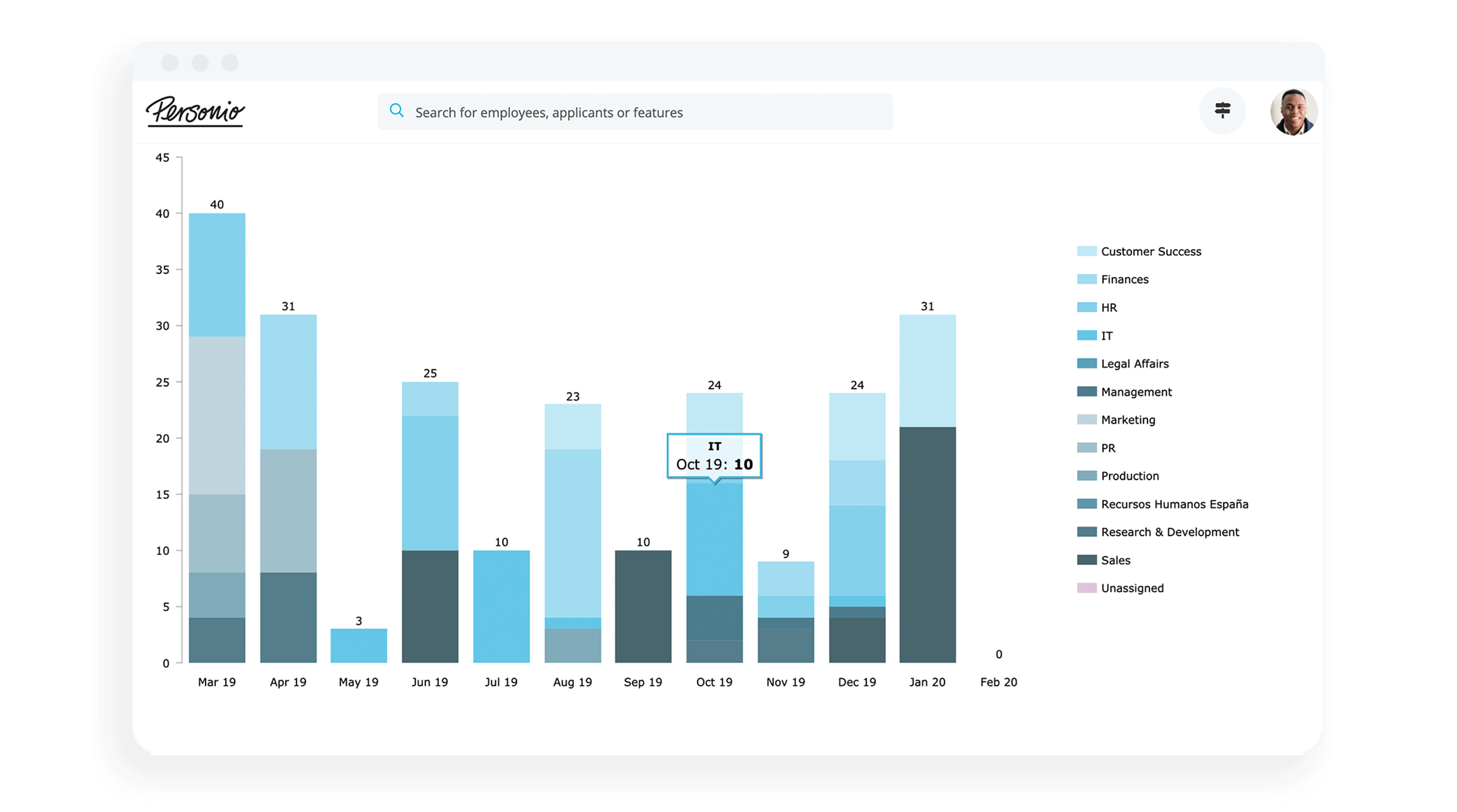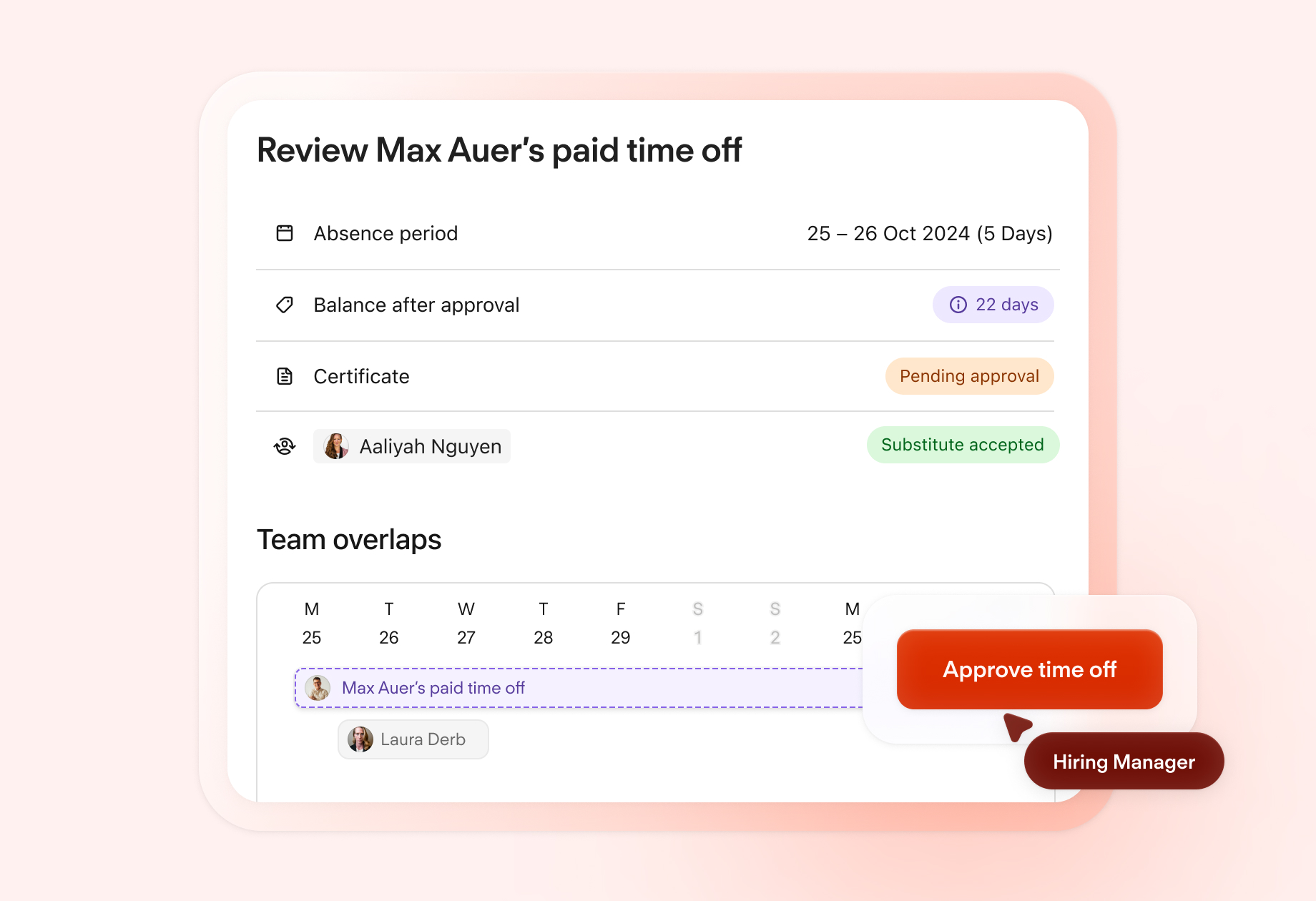Latest Blog Posts
Absence management methods, tips and best practices

Absence management refers to all of your organisation’s policies and practices concerning employee leave. That includes both planned holidays and impromptu time off.
The challenge is maintaining enough staff to keep operations running smoothly while letting everyone take the necessary leave.
With a well-defined strategy, you can strike the right balance. Effective absence management allows you to raise attendance, minimise disruption and put your team first.
How absence management impacts your team
The way you manage absence has far-reaching and long-term consequences for your organisation. Here’s what can happen when you have an effective strategy in place.
Higher attendance: By tracking leave and identifying patterns, you can find issues faster. You can then develop strategies to support employees and reduce absenteeism in the workplace.
Increased performance: Great absence management guarantees everyone gets sufficient time off to rest and recuperate. Teams can’t perform at their best without breaks.
Fewer unauthorised absences: Clear processes and policies make it easier for employees to follow company rules.
Improved staff morale: If your organisation takes a generous approach to leave, employees will see you put their needs first and feel supported.
Balanced workloads: When you manage absences well, you give yourself sufficient time to plan covers and distribute workloads fairly.
More hiring power: Many job seekers choose organisations based on how well they support work-life balance and time off.
The top challenges to absence management
Absence management is simple on paper. All leadership teams have to do is organise leave and arrange cover for absent workers. The reality is more complex due to the following factors:
Tracking leave: Recording and categorising all the different types of leave can be complicated, especially if you have a large workforce.
Arranging handovers: Departments need to carefully plan and prepare to cover for missing colleagues without causing stress or disruption.
Dealing with sudden absence: Many types of absence are unexpected, such as sickness, injury and compassionate leave, making them hard to plan for.
Handling issues sensitively: Staff may violate company policies due to difficult personal circumstances, which requires balancing disciplinary action with empathy and understanding.
Managing policies: Company rules and guidelines must be thorough to address the procedures for every type of employee absence.
Maintaining compliance: Most businesses say staying updated with all the complex laws concerning statutory leave is one of their top challenges.
Seamless absence management at your fingertips

Save up to 80% of the time spent processing leave requests. With a bird’s eye view of all absences, capacity planning is simpler than ever.
Learn moreTop absence management tips and best practices
Absence management becomes easier with a standardised approach. However, you must build some flexibility into your system to account for unexpected challenges and unique circumstances.
Here are some tips on managing absence without losing sight of individual employees.
1. Standardise your absence management policies
Create detailed policies about all types of leave so everyone knows what processes to follow. That includes both planned and unplanned absences. Even if circumstances are beyond the employee’s control, they may have responsibilities like providing a sick note.
Standardised policies help you keep absence management fair and consistent. Conor Hughes, HR Expert for SHRM, says: “The rules for taking time off should be the same no matter what. If they feel like someone is getting special treatment, it can create frustration or even conflict.”
Arrange workshops to explain absence management policies and ensure everyone is aware of their rights and responsibilities. This is key for reducing presenteeism.
Some 37% of employees confess to working when they’re sick, injured or distracted and therefore unable to perform their jobs. They’ll be more likely to take the necessary time off if they know your company encourages it.
2. Take extenuating circumstances into consideration
While it’s best to make everyone follow one set of rules, there may be occasional exceptions. Rely on policies for cut-and-dried situations and handle complex issues on a case-by-case basis.
Consider waiving policies or being lenient when:
Some circumstances are beyond the employee’s control
Intense stress or emotional strain affected their decision-making
Conflicting priorities caused them to take time off
Exceptions don’t just apply to serious situations like bereavement or family emergencies. Otherwise great employees can make small mistakes that prevent them from coming to work such as locking themselves out of their car or mixing up holiday dates.
Consider factors like their attendance history and usual conduct to decide whether the consequences are proportionate.
Provide training to help HR and line managers identify extenuating circumstances and judge individual cases. Alternatively, you can encourage online courses. For example, Bitesize Learning has a session on understanding the factors that impact employee absence.
3. Give your employees flexibility
Flexible working hours let employees fit their work schedule around their personal obligations and commitments. They’re less likely to use all their time off on appointments and family events, reducing the need for unpaid leave.
Introduce a policy that gives everyone the freedom to decide their hours. You can include stipulations about completing all work by the deadlines and keeping managers updated about progress.
Depending on your industry, you may need them to be available for specific hours to attend meetings, collaborate on projects and talk to customers.
The immediate advantage is that employees require fewer days off so you can maximise attendance levels. HR teams can spend less time approving leave and arranging cover.
UK research shows that flexible work can increase productivity and engagement. Teams get tasks done when it suits, making it easier to focus and produce quality work. They also use annual leave to relax instead of handling errands so they’re less likely to get burned out.
4. Talk to your team
Get feedback from employees when deciding on policies or introducing perks. They can tell you what they need to improve attendance and make the most of their leave. With their input, your strategies are more likely to have a positive impact on absence levels.
Conducting surveys can help you see which initiatives are the most popular. Keep them anonymous to get your staff’s honest opinions. Sometimes you must dig deeper into why a specific employee took an unauthorised absence or started missing work.
Jamie Smith, Head of People and Culture for RGF Staffing says: “You never know what will come out of these conversations and managers feel unprepared. But it’s only by truly getting to understand the person’s circumstances that you can make reasonable adjustments.”
The key is focusing on how you can support employees. Clarify your expectations and ask team members how you can help them meet these. For example, someone struggling with anxiety might benefit from working from home where it’s easier to manage their symptoms.
5. Set up leave workflows
Leave workflows minimise the disruption caused by staff absence. These help departments plan how to cover an employee’s regular duties and get them up to speed upon their return.
Including all the following items in the pre-leave workflow makes it less likely that important issues will get overlooked:
Advance notice: Ask departments to manage holiday requests at least a month in advance so you have time to arrange cover and prepare them.
Task handover: Get a list of all the tasks employees usually handle so you know what needs to be covered.
Delegation: See which of their peers has the capacity and the expertise to handle their workload.
Tools and resources: Make sure the employee gives all the materials required for their work to colleagues.
Notifications: Have employees set an automated response for emails that explains when they’ll return and who to contact in the meantime.
Post-leave workflows aren’t necessary for a short term absence. However, it’s worth arranging a check-in on an employee’s first day back to see if they have any issues.
Consider running return to work interviews when someone’s been off unexpectedly or taken a leave of absence. They’re most likely to need support transitioning back into the workplace.
Start by asking what accommodations they may need. For example, new parents might benefit from a phased return to work. You can take this opportunity to update them about projects and explain their current responsibilities if they’ve changed.
6. Use absence management software
Leave management software works by letting employees request leave via a centralised HR platform. They can choose dates from the calendar, select their type of absence and upload documents where necessary. If they’re responsible for arranging cover, they can add their colleague’s name. All managers need to do is review the details and click approve.
As employees accrue and take leave, the HR software automatically calculates their paid time off balance. They can check anytime by logging into their account via a mobile app. Automation still allows full control over processes and minimises compliance risks.
As Conor says, “Keeping track of [all the rules] can be tough, but using an automated system can make it much easier. These systems help ensure that everything is done according to the book so there are no surprises later on.”
You should be able to set and enforce:
Which types of absences to allow
Annual leave entitlement
Accrual rates and methods
Which roles and locations must follow specific policies
HR software delivers the best results when everyone uses it. Get everyone on board by explaining the benefits to both individuals and the organisation. Teams are almost twice as likely to continue using technology if they see how it supports their work.
Choose a platform with simple, user-friendly features so employees can manage tasks themselves. There’s less chance they’ll get frustrated and turn to HR with routine questions.

7. Understand trends in absences
Analyse your company data to look for trends and patterns. These often indicate opportunities to refine your strategy or potential issues with your absence management.
The key metrics to watch are:
Total absences
Absence frequency
Absenteeism rates
The average duration of leave
Filter this data by time, department and type of absence to identify trends. For example, you can see who takes the most unauthorised absences or which times of year have the highest attendance dates. You can use these insights to investigate further and inform decisions.
Suppose one department saw a sudden jump in sickness absence. Further research might reveal they’re frequently understaffed and require more leave for work-related stress. Now you know to redistribute some of their workload or hire extra personnel.
HR platforms like Personio can help you collect and analyse this data. As staff use the system to manage absences, it automatically records metrics like length and type of absence.
Personio then collates all this information and visualises it as interactive charts and graphs. If you want to explore the data from a specific perspective, you can easily create custom reports.
Manage team absence more effectively with Personio
Absence management works best when you can focus on employees. Your HR team should be free to support everyone whether they’re struggling with personal issues or just arranging a much-needed holiday.
Personio can make this happen with our absence management system. Our software automates the entire process of tracking and organising leave while applying the rules you set.
Make absence management a breeze

Generate absence management policies and make it easy to request and approve leave with Personio’s automated absence management system.
Learn moreFAQs
What is an example of absence management?
A common example of absence management is monitoring different kinds of leave across an organisation. This involves keeping a record of who’s absent and for how long. HR can use this information to check they have adequate staffing and reassign duties as needed.
What are the key concepts of absence management?
The key concepts of absence management are keeping departments fully staffed and supporting employee wellbeing. Maximising attendance and balancing workloads allows your organisation to remain productive. However, giving everyone time off ensures they maintain a healthy work-life balance and come to work engaged.
What are absence management solutions?
Absence management solutions are software you can use to monitor, measure and organise employee leave. They usually include automation for processes like requesting leave and calculating time off balances. Administrators can configure their system by creating custom policies and applying them to specific groups of employees.


